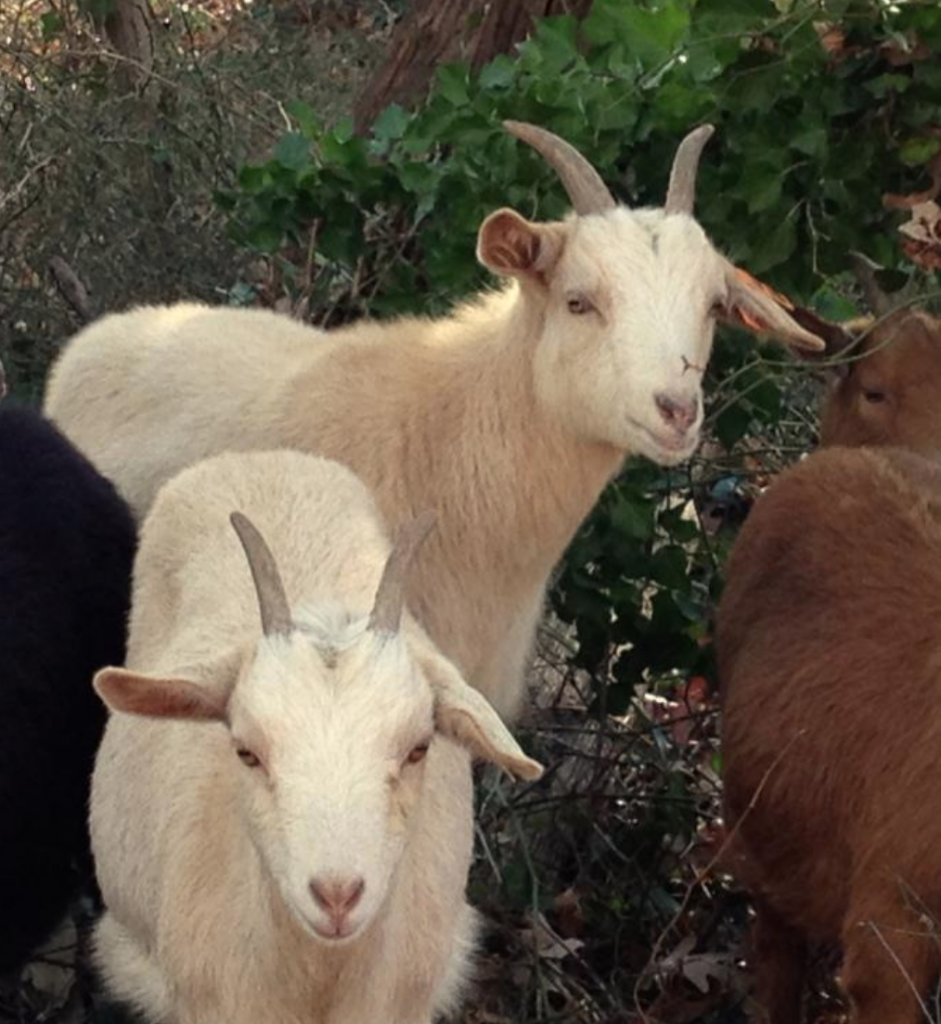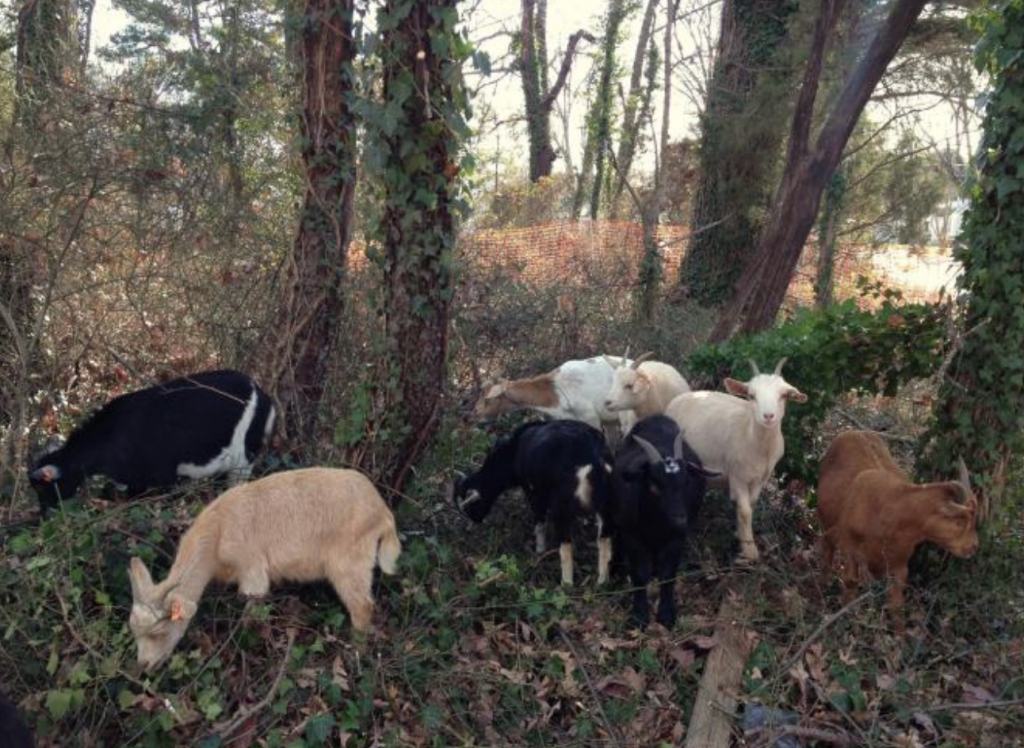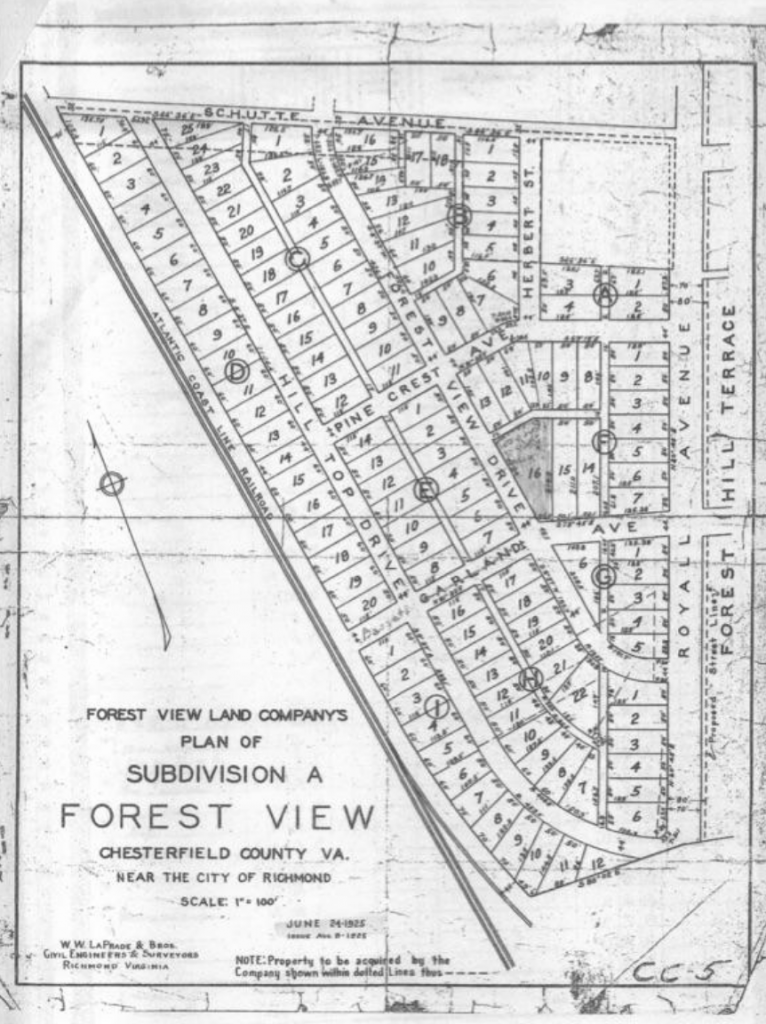Awesome Project: A Historic Cemetery Comes Alive… With Goats!
Published March 23, 2018
“It started with the trees,” says Melissa Linkous, an ioby Leader in Richmond, Virginia. “There were these beautiful mature oak trees I could see from my kitchen window, but they were being choked by poison ivy. So initially I was just trying to save the trees, and that’s how I discovered we had a cemetery.”
Melissa’s project, Preserving Forest View Cemetery, aims to restore this neglected historic site so it can once again serve as a place of peace, remembrance, and beauty for the community. She’s doing it with the help of her neighbors and friends, some city employees, a local archaeologist, and… a herd of goats.

Forest View Cemetery was founded sometime before 1898; Melissa has a map from that year that features it. As recently as the 1950s, it was still recognizable as a graveyard: some of her neighbors remember playing among its headstones as kids. But in the years since, the land fell into neglect and became blanketed in poison ivy and brush piles, and strewn with trash and junk like old air conditioners and machine parts. “Most of my neighbors didn’t know it was a cemetery, either,” Melissa says. “I don’t think people were trying to bring the neighborhood down, but it just looked like an abandoned lot. We didn’t want to breathe too heavily when we walked by—we were afraid of getting poison ivy in our lungs! It was that covered.”
Last year, Melissa founded Friends of Forest View Cemetery to spearhead restoration efforts. “We’ve had neighborhood meetings, and I’ve used social media and walked door to door to pass out flyers and talk to people,” she says. “I’d start telling them about the project and they’d say, ‘Hey, you’re the girl with the goats! I’ve heard about you!’”
Ah yes, the goats. “I’ve learned a lot about goats lately,” Melissa says. “For one, they love poison ivy. It’s like candy to them. I didn’t want to use herbicides to take down the overgrowth, and my neighbors agreed.” She explains that goats also tread lightly, and can get to places big machines can’t, making them ideal for clearing historic areas. In addition, machines can remove plants that are already growing, but they leave the seeds, whereas goats eat the seeds, too, preventing regrowth. “And they’re cute,” Melissa says.

This past winter, the first phase of Preserving Forest View Cemetery kicked off with a team of 10 munchers from RVA Goats and Honey (and their human helpers) clearing about a quarter of the property. “There’s something very zen about watching goats,” Melissa says. “It’s very meditative. Plus they brought a lot of awareness to the project.” Friends of Forest View Cemetery invited neighbors to come out and watch the goats do their thing for a few days shortly before Christmas. The group’s efforts were covered by local news outlets, and they raised all the money they needed through their ioby campaign.
Phase two of the project is slated to commence in mid-April, when a bigger herd of goats will be brought in to clear the remainder of the cemetery. Melissa is also working with the city’s preservation planner and attorney’s office on a plan to transfer the land to Richmond’s parks department. “When I started looking into the history, I found that the land is owned by the cemetery itself, and its mailing address is the actual cemetery—so that explains in part why it’s been forgotten for so long,” she says. “It’s been tax delinquent for many years. Luckily the city has been very helpful and responsive; they care about the project, which is wonderful. So now we’re working with them to see how best to protect this place in perpetuity.”

A woman who works in preservation and planning for the city knew of a local archaeologist who wanted to assist with the project. “Just by observing the land, he was able to identify several burial sites,” Melissa says. “Once we clear the entire cemetery, we can use ground-penetrating radar and lift the topsoil to study the soil patterns and find other graves.”
“There’s neighborhood lore that tells us this may have been a slave cemetery, and that a Native American man lived there and tended the well, and that he’s buried there, too,” Melissa says. “Right now, we don’t know how many people are there, or who they were. We just know they were people, and they need to be honored.”
Melissa’s long-term goal is to get proper fencing around the cemetery, populate it with native plants and a butterfly garden, and provide “places to sit and just be among the trees—without a lick of poison ivy!” She envisions a haven visitors can turn to for calm and contemplation, and where wildlife from the nearby James River can thrive. “You’ll hear great horned owls, choruses of barred owls,” she says. “We see rabbits, raccoons, falcons, hawks, great blue herons, chipmunks, possums. We want this restoration to happen for them, too!”
“A cemetery is a place where people bury their people,” Melissa says. “A place where love is felt and grief is felt. It’s not just a grassy spot with some trees. It should remain still, but preserved. Ours has been covered up for decades. I’m glad the trees told me about it.”
Preserving Forest View Cemetery – Phase Two is funding until April 15! Visit Melissa’s campaign page to chip in and support her work. (She says rewards are coming soon—like a “meet & greet photo op” with the goats!)
